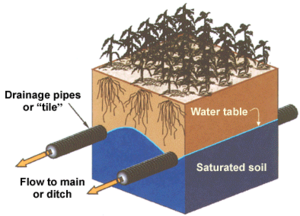Tile Drains: How much of a Water Quality Problem?

Schematic of tile drainage. Image from University of Minnesota Extension.
Tile drains are used extensively by farmers in the Champlain Valley and beyond to increase crop productivity on marginal lands. Drains work by lowering the water table allowing more oxygen to reach crop roots. LCC recently attended a tile drainage conference at the William H. Miner Agricultural Institute. The conference brought together farmers, regulators, consultants and non-profits to learn about water quality impacts and the best ways to limit their effect.
Unfortunately, the state of knowledge about impacts on water quality is pretty murky. Drains usually discharge to a nearby stream. Drain water carries dissolved phosphorus and nitrogen to receiving waters. However, in the absence of drains more water might flow overland to streams carrying sediment-bound phosphorus and nitrogen. At least when water seeps into drains, there is a chance soil will filter out and bind the nutrients. To protect water quality should we be more concerned about the forms of nutrients, such as dissolved nutrients that are more biologically available for algae growth, or the quantity? To complicate matters, in heavy clay soils that are subject to cracking, water runs directly to the tiles through the cracks by-passing any benefits from filtering.
Part of the conference discussed means of limiting nutrient loss through tiles. Adding control structures to the tiles to vary the amount of water discharged can be effective at reducing losses particularly in the fall. Treatment structures may be added to the end of tiles. Both bioreactors (essentially boxes filled with wood chips) and wetlands have been utilized for this purpose though they seem to work better for nitrogen than phosphorus. New tools have been developed to better target nutrient additions to fields so that more ends up in the plants which will be harvested and less ends up in the water.
The use of tile drainage is and will continue to be a significant factor in understanding and remediating lake pollution. Whether the overall impact is positive or negative is still unclear at this time.
